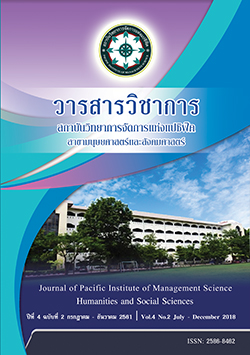Teamwork and Job Satisfaction Effecting Organizational Citizenship Behavior of the Industrial Manufacturing Factory Employees in Pathumthani Province.
Keywords:
Team working, job satisfaction, organizational citizenship behaviorAbstract
The objective of this study were to study 1) the significant level of team working, 2) the significant level of job satisfaction, 3) the significant level of organization citizenship behavior, and 4) team working and job satisfaction effecting organization citizenship behavior. The population of the study were industrial manufacturing factory employees working at 3,887 factories in Pathumthani province. The study sample consisted of 385 respondents from 30 factories selected by purposive sampling. Sample size was calculated using W.G.Cochran (1953) Formula. The data were collected by questionnaires. The IOC of the questionnaire was at .947. The reliability of the questionnaire was tested using Cronbach’s Alpha Coefficient which was at .940. The data were analyzed using frequency, percentage, mean, standard deviation and multiple regression.
The study result showed that :
1) The significant of team working of all aspects as a whole were at high level (=3.65).When considered each aspect, it found that objectives and joint goals were the highest (
= 3.73), followed by team working relationship (
= 3.61) and trust (
= 3.61) respectively
2) The job satisfaction of all aspects as a whole were at high level (= 3.57). When considered each aspect, it found that compensation was at highest level (
= 3.70), followed by commander (
= 3.68), colleague (
= 3.61), working condition (
= 3.50), task (
= 3.47), and growth opportunity (
= 3.46) respectively.
3) The significant of organization citizenship behaviors of all aspects as a whole were at high level ( = 3.57), When considered each aspect, it found that taking into account was the highest (
= 3.63), followed by sports manship (
= 3.52), realize the duty (
= 3.59) cooperation (
= 3.64), assistance (
= 3.40) respectively.
4) Job satisfaction and team working effecting the organizational citizenship behavior showed that:
Team working effecting the organizational citizenship behavior was positive and high relationship (b = 0.865, β=0.860, R2 = 0.74, 74.0%)
Job satisfaction effecting the organizational citizenship behavior was positive and high relationship (b = 0.804, β=0.940) with statistically significant difference at .01 (R2 = .873, 87.3%)
Team working effecting job satisfaction was positive and high relationship with statistically significant difference at .01 (b = 0.840, β = 0.865), R2 = 0.79, 74.9%)
References
ทำเนียบโรงงานอุตสาหกรรม. (2561). www.industry.go.th (ข้อมูล ณ วันที่ 28 กุมภาพันธ์ 2561)
Butler, M.J.R., & Rose, E. (2011). Introduction to Organizational Behavior. Chartered Institute of Personnel and Development (CIPD). London.
Casey and Michelle De Haan. (2002). Introduction: new methods in developmental science. Developmental science First published: 16 July 2002
Chughtai, Aamir Ali & Zafar, Sohail. (2006). Antecedents and Consequences of Organizational Commitment. Among Pakistani University Teachers. Applied H.R.M. Research, Volume 11, Number 1, pages 39-64.
Creswell, John W. 2009. Research design: qualitative, quantitative, and mixed methods approaches. Los Angeles: Sage.
Dessler, G. (2004). Management Principles and Practice for Tomorrow’s Leader. 3rd Edition,Pearson Education Inc., Upper Saddle River.
Douglas L. Kruse & Joseph R. Blasi & Richard B. Freeman. (2012). Does Linking Worker Pay to Firm Performance Help the Best Firms Do Even Better. NBER Working Papers 17745, National Bureau of Economic Research, Inc.
Goldberg, Alan J. and Fleming, William P. (2010). Cost-Containment and Cost-Management Strategies. Journal of Healthcare Management 55:5 September/October 2010
Lavelle, J. J., Rupp, D. E., & Brockner, J. (2007). Taking a multifocal approach to the study of justice, social exchange, and citizenship behavior: The target similarity model. Journal of Management, 33(6), 841-866.
Muchinsky Paul M. (2000). Emotions in the workplace: the neglect of organizational behavior. Journal Organizational behavior.
Organ, D. W., Podsakoff, P. M., & MacKenzie S. P. (2006). Organizational citizenship behavior. Its nature, antecedents, and consequences. London: Sage Publications.
Podsakoff, Philip M., Scott B. MacKenzie, and Nathan P. Podsakoff. (2012). Sources of Method Bias in Social Science Research and Recommendations on How to Control It. Annual Review of Psychology, Vol. 63, pp. 539-569.
Podsakoff, P. M., MacKenzie, S. B., Paine, J. B., & Bachrach, D. G. (2000). Organizational citizenship behaviors: A critical review of the theoretical and empirical literature and suggestions for future research. Journal of Management, 26(3), 513-563.
Podsakoff, N. P., Whiting, S. W., Podsakoff, P. M., & Blume, B. D. (2009). Individual- and Organizational - level consequences of organizational citizenship behaviors: A met analysis. Journal of Applied Psychology, 94(1), 122-141.
Sheikh Raheel Manzoor, Hafiz Ullah, Murad Hussain, Zulqarnain Muhammad Ahmad. (2011). Effect of Teamwork on Employee Performance. International Journal of Learning and Development. Accepted: October 20, 2011
Swanson, H. L. (2000). Issues facing the field of learning disabilities. Learning Disabilities Quarterly, 23 (1), 37-50.
The Gallup Organization. (2008). Employee Engagement. Gallup’s Research-Based Approach.Retrieved February 25, 2010, from. http://gmj.gallup.com/content/126173/Bolster- Employ-ees-Confidence.aspx.
Weiten, M.A. Lloyd. (2003). Psychology Applied to Modern Life: Adjustment in the 21st Century. Article with 111 Reads. Source: OAI. Cite this publication.
Woodcock, M. and Francis, D. (1994). Teambuilding Strategy. Hampshire: Gower Publishing
Downloads
Published
Issue
Section
License
บทความที่ได้รับการตีพิมพ์เป็นลิขสิทธิ์ของ สถาบันวิทยาการจัดการแห่งแปซิฟิค
ข้อความที่ปรากฏในบทความแต่ละเรื่องในวารสารวิชาการเล่มนี้เป็นความคิดเห็นส่วนตัวของผู้เขียนแต่ละท่านไม่เกี่ยวข้องกับสถาบันวิทยาการจัดการแห่งแปซิฟิค และคณาจารย์ท่านอื่นๆในสถาบันฯ แต่อย่างใด ความรับผิดชอบองค์ประกอบทั้งหมดของบทความแต่ละเรื่องเป็นของผู้เขียนแต่ละท่าน หากมีความผิดพลาดใดๆ ผู้เขียนแต่ละท่านจะรับผิดชอบบทความของตนเองแต่ผู้เดียว







